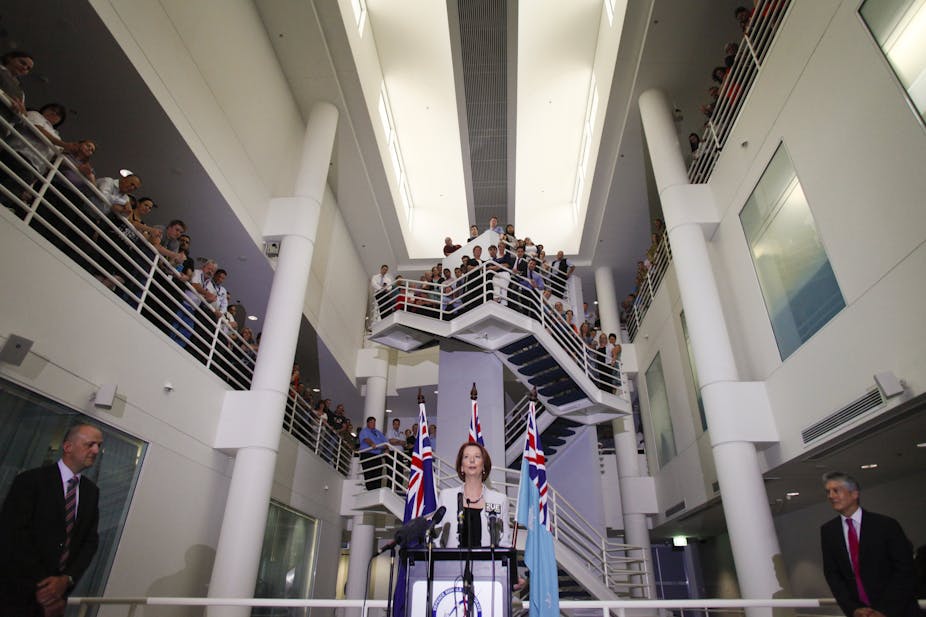The central problem for defence and security planners right now is uncertainty. The clarity of the Cold War is gone, new threats such as terrorism have come, and seemingly peaked, and what the rise of China and India means for regional stability is impossible to tell. Like Schrödinger and his famous cat, we don’t know if the box marked “future” holds war or peace, prosperity or decline.
Under former prime minister Kevin Rudd, the government sought to confront this uncertainty. In the diplomatic sphere Rudd was a systems builder, advocating an Asia-Pacific Community where great powers could mediate the challenges of the day. In the defence sphere, he wanted significant new air and maritime capabilities, unsubtly directed towards China.
By comparison, prime minister Julia Gillard seems more comfortable with complexity. Instead of seeking to overcome it, Gillard’s strategy is to work within it. The 2013 National Security Strategy aims only to improve Australia’s position until such time as we have a better understanding of the direction our region is heading. It might therefore be termed Schrödinger’s Strategy. The underlying logic seems to be that rather than worrying about what we can’t possibly know, let’s do what we can with what we have.
A comparison between the 2008 National Security Statement and the 2013 National Security Strategy is telling. The strategy identifies three goals to work towards, when there were ten in Rudd’s statement.
The new goals are improving our diplomatic and defence engagement with the region; a better approach to cyber security and increasing the vertical and horizontal cooperation between Australian security agencies (that is, between state and federal governments, and within the federal bureaucracy). Each is achievable and each helps in the long term, whatever outcome Australia faces.
The change in name – from “statement” to “strategy” – is also important. The 2008 document discussed what Australia’s environment and interests were and some of the main government agencies that addressed these issues. The 2013 document does this, but also tries to describe the link between what we want (ends), what we are doing to achieve it (ways), and what resources we have to dedicate (means). There is also a stark difference in language, suggesting that this time, the Department of Prime Minister and Cabinet and experts in the bureaucracy have written the document, not the prime minister personally, as seemed to be the case in 2008. This is for the better.
Notably, the United Nations has fallen away from the priority it had in 2008. The only references are to the United Nations Security Council seat Australia has for 2013/2014 and UN peacekeeping missions. Global multilateralism seems far less important this time around. There are other shifts too. The current document is more optimistic, but less certain. It’s more regional, but less ambitious. It is more focused on economics, and less on institutions. It’s also more concerned with outcomes than process. In short it promises less, cares more about where we end up, and admits there’s a lot we don’t know.
There are of course some problems with the document. The eight “pillars” of national security involve an odd mix of threats (terrorism, crime), resources (the US alliance) and aims (preserving border integrity, gaining understanding and influence in region). The strategy mentions the risk of other states trying to coerce Australia on economic, political or military grounds without explaining why these issues have leaped into the forefront of government thinking.
The biggest failing, however, is the question of resources. The strategy places high priority on improving our diplomatic engagement with the region, yet our diplomats remain on a starvation diet. Military-to-military diplomacy is also given significant responsibility, yet the recent cuts to defence are already curtailing existing efforts. As noted above, good strategy is the connection of means to ends, and yet this document offers no new funding, or even recognition that current funding is plainly inadequate.
These concerns aside, the 2013 National Security Strategy is to be praised. It tackles the hardest question in Australia’s defence and security planning today, namely uncertainty, and embraces it. It tells us what the government thinks about Australia’s position, the main goals it has and some of how it intends to get there.
There are still a lot of fuzzy words – “enhance”, “focus”, “encourage” or “continue to develop” – but the meaning is clear enough. If these strategies become a regular habit of the Australian government, we might not have guaranteed security, but we should end up better off than Schrödinger’s Cat … maybe.

